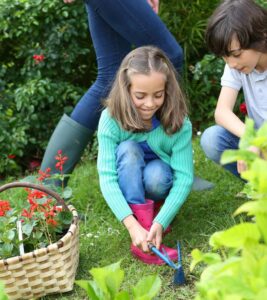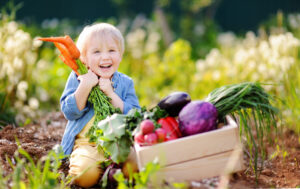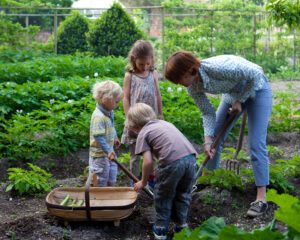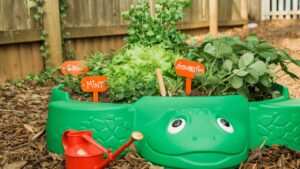Organic gardening for kids isn’t just about growing plants; it’s a doorway to a world of discovery and learning, especially for kids. Introducing children to organic gardening offers them a hands-on experience with nature, teaches them the importance of caring for our environment, and provides valuable lessons in patience and responsibility.

Did you know that studies show kids involved in gardening activities improve their science test scores by up to 12%?
This article will guide you through fun and educational activities to engage your little ones in organic gardening. Let’s plant the seeds of knowledge and watch them grow into future environmental stewards together!
Understanding Organic Gardening For Kids
Organic gardening means using only natural resources—sunlight, water, and healthy soil—without synthetic chemicals. This approach ensures that the fruits, vegetables, and flowers we grow are safe and nutritious.
By avoiding harmful chemicals, organic gardening protects the environment, keeping air and water clean and maintaining soil health. This sustainable practice benefits not just the current ecosystem but future generations as well.

Organic gardening is not only environmentally friendly but also promotes healthier food options. Studies suggest organically grown produce can be richer in nutrients and taste better. Organic gardening supports a healthier lifestyle and a cleaner, more sustainable planet.
Educational Activities In Organic Gardening For Kids
Gardening offers children practical lessons in ecology, science, and responsibility. This chapter outlines activities in organic gardening that engage young minds, covering seed starting, composting, and garden maintenance. Through hands-on involvement, children understand the environment and their role in nurturing it.
Seed Starting and Planting
Starting with planting seeds, children learn about plant biology and the conditions necessary for growth. Transparent containers can be used for planting to demonstrate germination, showing roots developing visually and stem growing, which makes the process tangible for children.
The activity teaches them how plants grow and the importance of patience and care in nurturing life.
Educational experiments further enrich this learning experience. For example, using kitchen scraps to grow plants teaches children about regeneration and sustainability, illustrating how waste can be transformed into new life.
Such activities provide a foundation for understanding plant life cycles and the environmental conditions affecting growth.
Composting with Kids
Composting introduces children to organic waste recycling, teaching them how decomposition creates nutrient-rich soil. By setting up and maintaining a compost bin, they learn which materials are compostable and observe the decomposition process.
This hands-on activity helps children understand the importance of composting in reducing waste and enhancing plant soil.
Observing changes within the compost bin, such as the transformation of waste into compost, illustrates the principles of recycling and decomposition. Regular contributions of kitchen and garden waste to the compost bin involve children in a sustainable practice, fostering environmental stewardship.
Garden Maintenance and Observation
Routine garden tasks teach children about the responsibilities involved in plant care. Watering, weeding, and mulching offer practical lessons in maintaining a healthy garden.

Observing plant growth, weather changes, and insect activity turns the garden into a living laboratory. Children learn about the ecosystem, including identifying beneficial insects and natural pest management methods.
Through these activities, children understand sustainable gardening practices and the importance of biodiversity. They gain practical skills and knowledge in organic gardening, fostering respect for the environment and encouraging a lifelong commitment to environmental stewardship.
Interactive Learning Projects In Organic Gardening For Kids
Interactive learning projects in the garden teach kids about nature, science, and creativity through hands-on activities. This chapter explores themed gardens, science experiments, and art projects that turn gardening into a learning adventure.
Themed Garden Projects
Creating a Pizza Garden
A pizza garden involves planting tomatoes, peppers, basil, and oregano in sections that mimic pizza slices. This project teaches plant life cycles and companion planting benefits, as certain plants together can naturally deter pests.
Planting a Butterfly Garden
A butterfly garden uses native plants to attract butterflies and other pollinators. It’s a practical way to teach the importance of pollinators, butterfly lifecycles, and habitat conservation. Observing and documenting butterfly visits can be an engaging activity for children.
Designing a Sensory Garden
Sensory gardens feature plants that stimulate touch, sight, smell, taste, and hearing. These gardens encourage interaction with the natural world, fostering appreciation for diversity and the importance of sensory experiences. Sensory gardens can also serve therapeutic purposes, offering a peaceful environment for children, including those with special needs.
Science Experiments in the Garden

Experiments on Photosynthesis and Plant Processes
The garden serves as a living lab for understanding photosynthesis and plant nutrition. Simple experiments like observing plant growth towards light or changing flower colors through dyed water demonstrate basic biological processes and encourage scientific inquiry.
Soil Testing for Plant Health
Participating in soil testing introduces kids to soil pH and its impact on plant growth. Using testing kits, children can learn how to adjust soil conditions, practically teaching them about soil science and basic chemistry.
Art and Crafts in the Garden
Art Projects with Natural Materials
The garden provides materials for art projects like leaf rubbings and flower pressing. These activities encourage detailed observation of plant features and offer a creative way to preserve the garden’s beauty.
Building Habitats for Wildlife
Constructing birdhouses or insect hotels from natural or recycled materials teaches about ecology and biodiversity. These projects allow for wildlife observation and discussions about ecosystems and the roles of different organisms in garden health.
Harvesting and Beyond
Harvest time is a critical juncture in the gardening cycle, offering a blend of celebration and education.
This chapter delves into guiding children through harvesting, utilizing the garden’s yield in the kitchen, and the essential reflections and planning needed for future gardening efforts.
Enjoying the Fruits of Labor
Harvesting teaches children the right time and method to collect fruits, vegetables, and herbs, ensuring the garden’s continued productivity. This hands-on experience is not just about gathering produce; it’s an opportunity to impart knowledge on plant care even at the harvest stage.
Following the harvest, involving children in preparing dishes with the garden’s yield bridges the gap between gardening and cooking. This activity not only celebrates their hard work but also introduces basic culinary skills and the concept of healthy eating.
Delving into the farm-to-table concept can expand children’s understanding of the food system, emphasizing local produce’s environmental and health benefits. This discussion can highlight the importance of sustainable practices and the positive impact of local food systems on the environment.
Reflecting and Planning for Next Season
The end of the growing season is a time for reflection and planning. Evaluating the successes and challenges of the past season with children fosters critical thinking and resilience. This reflection process teaches that setbacks are part of learning and growth.
Seed saving from successful plants for next season’s garden introduces children to concepts of life cycles, sustainability, and plant genetics. This hands-on activity encourages responsibility and forward-thinking, setting the stage for future gardening endeavors.
Motivating children to continue their gardening journey involves setting new goals and encouraging the sharing of their experiences. Planning for the next season keeps their interest alive and supports the development of a deeper connection to gardening.
Conclusion
Embarking on the organic gardening journey with kids opens a gateway to exploration, learning, and growth. Through planting a seed, children dive into the wonders of the natural world, gaining invaluable lessons in ecology, patience, and stewardship.

This guide has walked you through various activities designed to nurture young environmental guardians, from the joys of harvesting their produce to the insightful reflections of a season’s end.
Armed with knowledge and hands-on experience, our young gardeners are not just growing plants; they’re growing into responsible caretakers of our planet. Let’s continue to sow the seeds of curiosity and watch as they blossom into the environmental stewards of tomorrow.
FAQs
What age is appropriate for kids to start organic gardening?
Children as young as 3 can begin organic gardening with simple tasks like planting seeds or watering plants, making it a fantastic way to introduce them to nature and the environment early on.
Can organic gardening improve kids’ science test scores?
Yes, engaging in organic gardening can enhance children’s understanding of biological processes and ecosystems, which has been shown to improve science test scores by up to 12% by providing practical, hands-on learning experiences.
What are the easiest vegetables for kids to grow in an organic garden?
Radishes, lettuce, snap peas, and cherry tomatoes are great for young gardeners. These plants are easy to grow and mature quickly, giving kids a fast and rewarding gardening experience.
How can organic gardening teach children about sustainability?
Organic gardening educates children on using natural resources responsibly, the importance of biodiversity, and the impact of chemical-free practices on the environment, laying the foundation for lifelong sustainable living habits.

Pingback: DIY Organic Garden Remedies and Solutions